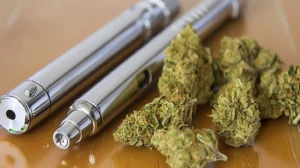Introduction to Watering and Nutrients for Cannabis Plants
As a cannabis cultivator, one of the most crucial aspects of successfully growing healthy plants is understanding their watering and nutrient needs. After years of trial and error, I have learned the importance of proper watering techniques and providing the right nutrients for my home-grown cannabis. In this article, I will share my personal experience and knowledge on how to properly water and nourish your cannabis plants for optimal growth.
My Experience with Growing Cannabis at Home
I have always been fascinated by the art of cultivating cannabis at home. Starting from a small grow tent in my closet to now having a dedicated grow room, my journey as a cannabis cultivator has been an exciting and fulfilling one. Along the way, I have made mistakes and learned valuable lessons, especially when it comes to watering and nutrient management.
Understanding the Watering Needs of Cannabis Plants
The watering needs of cannabis plants can vary depending on various factors such as the plant’s stage of growth, growing medium, and environmental conditions. It is essential to understand these factors and their impact on your plant’s watering requirements.
Factors Affecting Watering Needs
The size and stage of growth of your cannabis plant, the type of growing medium used, humidity levels, and temperature can all affect how much water your plant needs. For example, a smaller plant in a smaller pot will require less water compared to a larger plant in a larger pot. Additionally, plants in soil tend to need less frequent watering compared to those in hydroponic systems.
How to Determine When to Water
One way to determine when your plants need water is by using the finger test. Simply stick your finger into the top inch of the soil or growing medium, and if it feels dry, it’s time to water. Another method is to lift the pot and feel its weight. If it feels light, it may be time to water as the soil has dried out.
Proper Watering Techniques for Cannabis Plants
When it comes to watering cannabis plants, it’s crucial to use the right amount of water and to water using the appropriate techniques for your growing medium.
Using the Right Amount of Water
Overwatering is a common mistake among cannabis cultivators. It is essential to give your plants enough water, but not too much. A general rule is to give your plants enough water to thoroughly soak the growing medium and allow for proper drainage.
Watering Techniques for Different Growing Mediums
The techniques for watering will differ depending on whether your plants are grown in soil or hydroponically. In soil, water should be evenly distributed around the base of the plant, while hydroponically grown plants will require water in their reservoir.
Importance of Nutrients for Cannabis Plants
Along with water, providing the right nutrients is crucial for the healthy growth of cannabis plants. Nutrients are essential elements that plants need for their overall health and development.
Essential Nutrients for Cannabis Growth
There are six essential nutrients that cannabis plants need: nitrogen, phosphorus, potassium, calcium, magnesium, and sulfur. These are commonly referred to as NPK, and each plays a vital role in the plant’s growth and development.
How to Provide Nutrients to Your Cannabis Plants
Nutrients can be provided to your cannabis plants through various means, including organic and synthetic fertilizers, compost, and nutrient solutions. It is essential to follow the instructions on the nutrient product and monitor your plants closely to avoid over or underfeeding.
Understanding the Nutrient Requirements of Cannabis Plants
The nutrient requirements of cannabis plants will vary depending on their stage of growth. It is crucial to understand the different stages of growth and how to adjust the nutrient levels accordingly to avoid deficiencies or excess.
Common Nutrient Deficiencies in Cannabis Plants
It is essential to monitor your plants for any signs of nutrient deficiencies, such as yellowing or discoloured leaves. Common deficiencies include nitrogen, phosphorus, and magnesium deficiencies, which can be solved by adjusting your nutrient levels.
My Experience with Growing Cannabis at Home
As a cannabis enthusiast and home-grower, I have learned the ins and outs of cultivating this plant through trial and error. In this section, I will share my personal experience with growing cannabis at home, from setting up the grow space to harvesting the final product. Join me as I take you through my journey as a cannabis cultivator and the lessons I have learned along the way.
My Journey as a Cannabis Cultivator
As a cannabis cultivator, my journey has been filled with learning experiences, challenges, and rewards. I have honed my skills in nurturing cannabis plants, understanding their unique needs, and ensuring they receive the right balance of water and nutrients throughout their growth stages. This journey has taught me the importance of patience, observation, and adaptability in achieving healthy and thriving cannabis plants. From the initial stages of germination to the final harvest, each phase has contributed to my knowledge and expertise, shaping me into a more proficient cultivator.
Fact: Cannabis plants go through distinct growth stages, including germination, seedling, vegetative, flowering, and harvesting, each demanding specific care and nutrient adjustments.
Understanding the Watering Needs of Cannabis Plants
Proper watering is essential for the health and growth of cannabis plants. However, it can be a tricky task for novice growers. In this section, we will discuss the important factors that affect the watering needs of cannabis plants, including environmental conditions and plant characteristics. We will also provide tips on how to determine when it’s time to water your plants, ensuring they receive the perfect amount of moisture for optimal growth.
Factors Affecting Watering Needs
Factors affecting watering needs for cannabis plants include environmental conditions, plant size, growth stage, and the type of growing medium. Environmental factors such as temperature, humidity, and airflow directly impact the rate of water absorption and evaporation. Larger plants with extensive foliage require more water than smaller ones. Additionally, the growth stage influences water needs, with plants in the flowering stage requiring less water. The type of growing medium, whether soil, hydroponic, or coco coir, affects water retention and drainage, affecting the frequency and volume of watering.
Pro-tip: Understanding these factors allows cultivators to tailor their watering schedules to meet their plants’ specific needs, promoting healthier growth and higher yields.
How to Determine When to Water
To determine when to water your cannabis plants, follow these steps:
- Check the soil moisture by inserting your finger into the soil up to the first knuckle. If the soil feels dry at this depth, it’s time to water.
- Observe the weight of the container or pot. If it feels light, it indicates that the plant needs watering.
- Look for visual cues such as drooping leaves or wilting, which can signify the need for water.
- Monitor the drainage. When the top of the soil is dry, water the plant until it starts to drain from the bottom of the container.
Remember, maintaining proper watering is essential for healthy cannabis plants. Consistency and attentiveness are key to successful cultivation.
Proper Watering Techniques for Cannabis Plants
Water is a crucial element in the growth and health of cannabis plants. However, improper watering techniques can lead to various issues such as nutrient deficiencies, root rot, and mold growth. In this section, we’ll discuss the importance of using the right amount of water for your cannabis plants and how to properly water them depending on the type of growing medium you are using. These techniques will help ensure the optimal growth and development of your home-grown cannabis.
Using the Right Amount of Water
Calculate the water quantity based on the plant’s needs and the growing medium. Factors like humidity, temperature, and plant size influence the amount of water required. Use a container with drainage holes and monitor the water runoff to avoid overwatering or underwatering. Observe the plant’s response to watering – wilting, drooping, or yellowing leaves indicate potential over or under-watering. Consider the frequency of watering based on the plant’s growth stage and environmental conditions. Adjust the watering amount as the plant’s water needs change throughout its growth cycle.
My journey as a cannabis cultivator taught me the importance of using the right amount of water. It’s crucial to strike a balance to ensure healthy growth without causing water-related stress to the plants, ultimately leading to successful cultivation.
Watering Techniques for Different Growing Mediums
Soil: When watering cannabis plants grown in soil, ensure the soil is moist but not waterlogged. Water the plant until you see a small amount of runoff from the bottom of the pot to guarantee thorough hydration.
Hydroponics: In a hydroponic system, provide a continuous flow of nutrient-rich water to the roots. Monitor the pH and electrical conductivity of the nutrient solution to maintain optimal growing conditions.
Coco Coir: When watering cannabis in coco coir, ensure the medium is evenly moist. Water until you see a small amount of runoff, similar to watering in soil, to ensure proper hydration and nutrient uptake.
Aeroponics: In aeroponic systems, a fine mist of nutrient solution is sprayed directly onto the roots. Ensure the roots are misted at regular intervals to maintain adequate hydration and nutrient absorption.
Importance of Nutrients for Cannabis Plants
Proper nutrition is crucial for the growth and health of any plant, and cannabis is no exception. In this section, we will discuss the importance of nutrients for cannabis plants and how they contribute to optimal growth and development. We will also cover the essential nutrients that cannabis plants need for healthy growth and how to provide them in the most effective way. Understanding the needs of your cannabis plants is essential for achieving a successful and bountiful harvest.
Essential Nutrients for Cannabis Growth
Nitrogen: Essential for vegetative growth, aiding in the production of chlorophyll and amino acids.
Phosphorus: Crucial for flower development and root growth, playing a key role in energy transfer within the plant.
Potassium: Facilitates photosynthesis, regulates water uptake, and contributes to overall plant health and strength.
Calcium: Vital for cell wall structure, enzyme function, and nutrient uptake.
Magnesium: A component of chlorophyll, essential for photosynthesis and overall plant vigour.
Sulphur: Important for the synthesis of amino acids, vitamins, and enzymes.
How to Provide Nutrients to Your Cannabis Plants
Choose the correct nutrients:
Choose a balanced nutrient solution suitable for cannabis plants. Look for options with the appropriate ratio of nitrogen, phosphorus, and potassium.
Follow a feeding schedule:
Adhere to a feeding schedule based on the plant’s growth stage. Start with a lower concentration and gradually increase as the plants mature.
Monitor pH levels:
Regularly check and adjust the pH of the nutrient solution to ensure optimal nutrient uptake by the plants.
Consider supplements:
Incorporate beneficial supplements such as amino acids, enzymes, and beneficial microbes to enhance nutrient absorption and plant health.
Adjust based on plant response:
Observe the plants for any signs of nutrient deficiencies or excesses and modify the nutrient regimen accordingly.
As an experienced cannabis grower, I’ve learned that providing the right nutrients to cannabis plants is crucial for their growth and development. By carefully selecting quality nutrients, adhering to feeding schedules, monitoring pH levels, and adjusting based on plant response, I’ve been able to cultivate healthy and thriving cannabis plants in my home garden.
Understanding the Nutrient Requirements of Cannabis Plants
For any home-grower, understanding the nutrient requirements of cannabis plants is crucial for a successful and healthy harvest. In this section, we will delve into the different stages of growth for cannabis plants and what specific nutrients they need during each stage. We will also discuss some common nutrient deficiencies that may arise in cannabis plants and how to identify and address them. By the end, you will have a comprehensive understanding of the nutrient needs for your cannabis plants at every stage of their growth cycle.
Different Stages of Growth and Their Nutrient Needs
Seedling stage: During this stage, the plant requires higher levels of nitrogen to support the development of leaves and stems.
Vegetative stage: In this phase, the plant necessitates a balanced supply of nitrogen, phosphorus, and potassium to foster healthy foliage and root growth.
Flowering stage: At this point, the plant’s demand shifts towards higher phosphorus and potassium levels to facilitate robust flower and bud development.
Ripening stage: As the plant approaches maturity, it benefits from reduced nitrogen and increased phosphorus to enhance the ripening process and maximize flower quality.
When considering the different stages of growth and their nutrient needs, it’s crucial to tailor the nutrient supply to each phase to achieve optimal plant health. Adhering to a well-structured feeding schedule and utilizing quality nutrients can significantly impact the overall growth and yield of cannabis plants.
Common Nutrient Deficiencies in Cannabis Plants
Common nutrient deficiencies in cannabis plants can adversely impact their growth and health. Some prevalent deficiencies include:
- Nitrogen, which is evident through yellowing of the lower leaves.
- Phosphorus, which causes darkening or purpling of the leaves.
- Potassium, which leads to yellowing or browning of leaf edges.
Additionally, cannabis plants may suffer from magnesium and calcium deficiencies, which manifest as interveinal chlorosis and distorted leaf growth.
To address these deficiencies, it’s crucial to maintain a balanced nutrient regimen and pH levels in the growing medium. Conduct regular soil or water tests to monitor nutrient levels and adjust the feeding schedule accordingly. Choosing high-quality, cannabis-specific fertilizers can help prevent and rectify common nutrient deficiencies in cannabis plants.
My Personal Tips for Successful Watering and Nutrient Management
As a seasoned cannabis grower, I have learned the importance of proper watering and nutrient management for achieving healthy and robust plants. In this section, I will share my personal tips and techniques for successful watering and nutrient management. We will discuss the benefits of keeping a consistent schedule, the importance of using quality water and nutrients, and how to monitor and adjust as needed to ensure your plants receive the perfect balance of hydration and nourishment.
Keeping a Consistent Schedule
Set a regular watering and feeding schedule based on the specific needs of your cannabis plants. Keep a detailed journal to track the watering and nutrient schedule, as well as any adjustments made. Consistently monitor the condition of the plants to ensure that they are responding well to the established schedule. Adjust the schedule as necessary according to the growth stage and environmental factors affecting the plants.
As an avid cannabis cultivator, I always emphasise the importance of keeping a consistent schedule for watering and nutrient management. One memorable season, I meticulously adhered to a schedule, and the results were outstanding. The plants flourished, and the yield was exceptional, reaffirming the significance of maintaining a consistent regimen in cannabis cultivation.
Using Quality Water and Nutrients
Using quality water and nutrients is essential for the healthy growth of cannabis plants.
Start by sourcing clean, pH-balanced water to avoid introducing contaminants or disrupting the plant’s nutrient uptake.
Invest in reputable nutrient solutions specifically formulated for cannabis, ensuring they contain the necessary macro and micronutrients.
Regularly test the water and adjust nutrient levels to maintain optimal growing conditions.
Monitor the plant’s response to the water and nutrient regimen, making adjustments as needed to support vigorous and healthy growth.
Monitoring and Adjusting as Needed
Regular Monitoring: Continuously observe plant health, soil moisture, and nutrient levels to identify any deviations from the optimal conditions.
Adjusting Watering Schedule: Modify the watering frequency based on the plant’s needs, considering factors like temperature, humidity, and growth stage.
Adjusting Nutrient Levels: Periodically measure and adjust nutrient concentrations in the soil or hydroponic solution to maintain balanced nutrition.
Pro-tip: Consistent and attentive monitoring, along with timely adjustments, is key to ensuring the best growth and health for your cannabis plants.
.jpg)
Frequently Asked Questions
What is the suitable drainage for watering cannabis plants?
Proper drainage is essential for watering cannabis plants. It ensures that water is evenly distributed and prevents issues such as root drowning and mould. Using well-draining growing containers or open soil can help achieve suitable drainage for your plants.
What are the six reasons why over-watering can be harmful for cannabis plants?
Over-watering can cause numerous issues for cannabis plants, including nutrient shortages, plant health issues, damaged crops, slower growth, increased yield, and vulnerability to diseases. Proper watering techniques are crucial to avoid these problems.
How much water do cannabis plants need during the vegetative and blooming phase?
The amount of water cannabis plants need varies depending on the stage of growth. On average, a cannabis plant requires around 2.5-2.8 gallons of water per day during the vegetative phase and up to 6 gallons per day during the blooming phase.
What are some common techniques for watering cannabis plants?
Hand watering and using an irrigation system are two common techniques for watering cannabis plants. Hand watering allows for more precise control, while irrigation methods are useful for larger-scale cultivation. Monitoring soil moisture and using conservation techniques such as mulching can also help in watering.
What is the recommended water quality for indoor cannabis cultivation?
Tap water may contain chemicals and minerals that can affect plant growth, so using filtered or distilled water is recommended for indoor cannabis cultivation. This helps ensure that the plants receive clean and optimal water for maximum growth.
Nurture your cannabis cultivation skills with our expert newsletter! Dive into the essentials of proper watering and nutrient management for home-grown cannabis plants. Each issue is packed with professional advice, tailored tips, and the latest strategies to ensure your plants thrive. Whether you’re a beginner or an experienced grower, our insights will help you achieve optimal plant health and yield. Subscribe now and transform your cannabis growing experience with knowledge from the experts! 🌿💧






